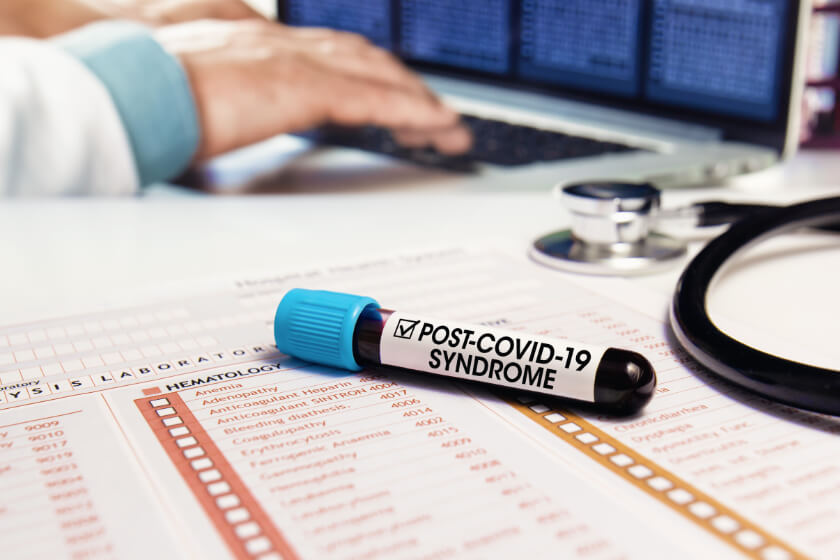

Lung Problems May Continue Two Years Later for those with Long COVID
The COVID-19 pandemic is over for most people, but for some, the effects of the virus continue two years after the infection. Known as “long COVID,” “Post-COVID Conditions (PCC),” or “long haul COVID,” the condition causes a wide range of ongoing health issues that can last weeks, months, or even years – in fact, nobody knows how long post-COVID can potentially last.
Diagnosing long COVID hasn’t been easy. Unlike COVID-19, there is no single diagnostic test for post-COVID. What’s worse, the long-term data on how long COVID affects the lungs two years later.
Study Shows Lung Abnormalities Continue Two Years After a COVID Infection in those with Long COVID
In a recent study, researchers looked at the changes in lung function and chest computed tomography (CT) findings in patients who recovered from COVID-19.
The researchers included 144 participants, aged 18 to 80, into the study. All the participants had been discharged from the hospital after a COVID infection between January 15 and March 10, 2020. The team of scientists excluded anyone who didn’t have a CT scan of the chest when admitted to the hospital, had a poor-quality chest CT scan upon admission, had a history of breathing problems, or whose breathing symptoms completely went away when they were discharged from the hospital.
Most of the study participants – about 78 percent – had severe COVID infections, but 4 percent of the participants were in critical condition. Nearly 1 in 5 had acute respiratory distress syndrome (ARDS), which occurs when fluid collects in the lung’s air sacs, thereby depriving organs of the oxygen the lungs deliver. People with ARDS have severe shortness of breath; many are unable to breathe on their own without the help of a ventilator.
The researchers also looked at the results of the participants’ pulmonary function tests, which are a series of tests that determine how well a person is breathing. The team of scientists looked at the health records of the participants, especially the records created while the patient was in the acute stage during hospitalization.
Using chest CT scans to detect long COVID
The researchers conducted in-person interviews during the three follow-up appointments, in which participants underwent a chest CT scan and filled out a questionnaire on their respiratory symptoms. The questionnaire asked the participants if they became short of breath during exercise (dyspnea), had a cough, or coughed up a lot of phlegm.
The participants underwent three chest CT scans and pulmonary function tests, at 6 months, 12 months and 2 years after their symptoms began. These CT scans show that lung problems can continue for some people who had COVID-19. After they got out of the hospital, participants had residual lung abnormalities, such as:
- Fibrosis (scarring)
- Thickening of lung tissue
- Honeycombing, which is the presence of random air spaces lined by fibrous tissue
- Cystic changes, such as overgrown lung tissue that forms fluid-filled cysts in the lung’s tiny air sacs
- Dilation (widening) of the bronchi, which are the breathing tubes that bring air into the lungs
- Other problems that caused pulmonary issues (breathing trouble)
The researchers looked for signs of progressive scarring of lung tissue, a group of conditions known as interstitial lung disease. The scientists used CT scans to detect interstitial lung abnormalities (ILAs) and other residual lung abnormalities that continued to cause breathing problems even after the active COVID infection was over.
The researchers also looked at the results of the participants’ pulmonary function tests, which are a series of tests that determine how well a person is breathing. The team of scientists looked at the health records of the participants, especially the records created while the patient was in the acute stage during hospitalization.
The results
Over the two-year course of the study, the incidence of lung abnormalities slowly decreased. Six months into the study, the chest CT scans showed lung abnormalities in 54 percent of the participants. At the two-year follow-up, though, the scans showed lung abnormalities in only 39 percent of participants; this means 61 percent of participants no longer had lung abnormalities on their CT scans.
The participants whose chest CT scans showed lung abnormalities were more likely to have breathing problems and abnormal lung function. Fortunately, the percentage of participants with respiratory issues decreased from 30 percent at six months to 22 percent at the 2-year mark.
At the 2-year follow-up, exertional dyspnea and shortness of breath were the most common respiratory symptom, with 14 percent of participants still having these breathing issues. The researchers observed mild to moderate pulmonary diffusion, which is how well the lung’s air sacs deliver oxygen to the body, in 29 percent of those participating in the study.
These findings suggest that the effects of COVID-19 continue long after the initial infection. The authors of the study suggest patients with COVID be followed closely by their healthcare team to detect and manage breathing problems.
For more information on the effects of long COVID, consult with your doctor. If you think you have long COVID, ask for a chest CT scan from RAI. Our team of radiology professionals know how to look for signs of long COVID, so you can get the treatment you need to feel better sooner.





